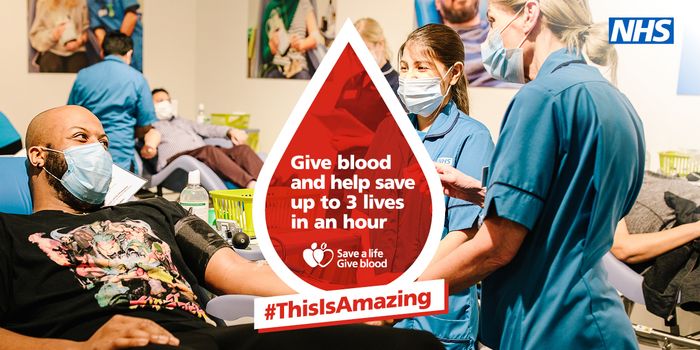Time to roll up those sleeves
This article is in partnership with NHS Blood & Transplant
Blood donation is a very small act that can have the most incredible impact on someone’s life. Right now, the pool of blood donors in the UK is at its lowest level in 25 years, so it’s time to roll up those sleeves and help save someone’s life.
So before you read on, why not register to become a blood donor by clicking here…
‘But it’s super complicated!’ we hear you say – well, actually you would be incorrect on that one. Donating blood has never been easier. Let’s take a look at some of the most common myths surrounding this all-important topic.
Myth #1 – Giving blood takes hours
Film and TV often depicts blood donations as a long, drawn-out process – but this could not be further from the truth. The entire process actually only takes about an hour, while the donation itself takes as little as 10 minutes.
The longest part of the process is the screening and health checks required to ensure that both you and your blood are in fighting shape. In total, the machine will take 470ml and stop automatically once the designated amount is taken.
After a quick snack and a drink, and a short period of monitoring, you’ll be on your way.
Myth #2 – I have to be 18 to give blood
Nope. You can register to donate at the age of 16, and you only have to be 17 to actually donate blood, meaning you could save as many as three lives during your lunch break in between classes!
Myth #3 – I can’t give blood if I have tattoos
Another misconception surrounding blood donation is that your skin needs to be free of art to give blood. Though the NHS requires some time between tattooing and blood donation, you could technically be covered head to toe in your favourite artwork and still give blood. Currently, you have to wait four months between the two activities – but don’t let that put you off.
If you have had a tattoo recently then you can still create an account and register for an appointment in the future, just sign up here.
Myth #4 – I need to know my blood type before applying
How many people know their blood type off the top of their head? Not that many, so if you don’t, then it doesn’t matter. You’ll find out your blood type shortly after your first donation, it usually takes a few weeks to find out. And don’t worry, you can’t fail the test!
Myth #5 – Donating blood really hurts
It’s easy to imagine something so important could actually be quite a big procedure, but this couldn’t be further from the truth. These aren’t randomers sticking needles in you but trained professionals who’ve literally done hundreds, if not thousands, of these procedures.
The whole process is designed to be as smooth and simple as possible, with the minimum pain and discomfort.
Myth #6 – Blood donation is dangerous; I need my blood
Of course, you do need your blood – but it’s not like you aren’t going to get it back! Your body replenishes the blood you’ve lost within 24-48 hours and your iron levels only take a few weeks to get to the level you were at before donating. Give it 12 to 16 weeks and you’re ready to donate all over again.
Myth #7 – I can’t give blood because I have asthma
There are some reasons why you may not be able to give blood but asthma isn’t one of them, check to see if you’re eligible to donate by using the donation knowledge base here.
If you are worried or concerned, then reach out to a medical professional for advice.
Myth #8 – You can’t give blood if you’re gay
This isn’t true, earlier this year, the rules around men who have sex with men and blood donation changed. The changes mean many gay, bi-men and men who have sex with men in a long-term relationship are now be able to donate blood at any time meaning more people than ever can donate. To understand the full extent of the changes you can read about them here.
BONUS Myth – Men and women can donate the same number of times a year
Typically, men can give more blood than women because they are statistically larger. Men can give blood every 12 weeks, while women have to wait 16 weeks to protect their iron levels.
Also, because men’s blood typically contains fewer antibodies, the blood can be used in a wide range of situations. It is often used to treat people with burns and cancer or those in accidents or with weakened immune systems.
So basically lads, get yourself down to your nearest centre because you could save someone’s life. And if reading this has you inspired to register to donate, then head this way to sign up and get started!
Related links:
- Ex-PM labels Boris Johnson “shameful”
- Tory MP says pay MPs more to avoid future lobbying scandals
- Campaigners rally against “racist” deportation flight





















































